Cornell University
 From Nwe
From Nwe 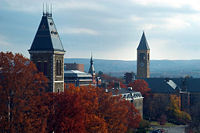
|
|
| Motto | "I would found an institution where any person can find instruction in any study." –Ezra Cornell, 1865[1] |
|---|---|
| Established | 1865 |
| Type | Private with 14 colleges and schools, including 4 contract colleges |
| Location | Ithaca, NY USA |
| Website | www.cornell.edu |
| †Regular full-time and part-time professorial faculty members. NYC Weill medical-division units have additional external affiliations with 867 full-time and part-time faculty members elsewhere. | |
Cornell University is a private research university located in Ithaca, New York. Its two medical campuses are in New York City and in Education City, Qatar. Cornell is a member of the Ivy League, and prides itself on providing an excellent education.
Established in 1865, Cornell was non-sectarian from the beginning, and was the first American university to admit women (in 1870). Its vision has always been to offer a broad curriculum that nonetheless strives to advance knowledge in areas useful to society. Situated in an area of farming, conservation, and recreation, the school naturally developed the study of agriculture. It also developed the first university publishing enterprise in America, which today is one of the largest in the country. Cornell's achievements, both by the institution itself and its alumni, are wide ranging and of much benefit to society. However, for Cornell to truly serve the world, attention must be paid not only to the mastery of knowledge and skills, but also to understanding of the heart and spirit of humankind.
Mission

The youngest member of the Ivy League, Cornell was founded in 1865 by Ezra Cornell and Andrew Dickson White as a coeducational, non-sectarian institution where admission was offered irrespective of religion or race. Inaugurated shortly after the American Civil War, its founders intended that the new university would teach and make contributions in all fields of knowledge — from the classics to the sciences and from the theoretical to the applied. These ideals, unconventional for the time, are captured in Cornell's motto, an 1865 Ezra Cornell quotation: "I would found an institution where any person can find instruction in any study."[1]
History
Cornell University was created on April 27, 1865 by a New York State Senate bill that named the university as the state's land grant institution. Senator Ezra Cornell offered his farm in Ithaca, New York as a site and $500,000 of his personal fortune as an initial endowment. Fellow senator and experienced educator Andrew Dickson White agreed to be the first president. During the next three years, White oversaw the construction of the initial two buildings and traveled about the globe, attracting students and faculty.[2]
The university was inaugurated on October 7, 1868, and 412 men were enrolled.[3] Two years later, Cornell admitted its first women students, making it the first coeducational school among what came to be known as the Ivy League. Scientists Louis Agassiz and James Crafts were among the faculty members.[2]
Cornell expanded significantly in the twentieth century, with its student population growing to its current count of about 20,000 students. The faculty expanded as well; by the century's end, the university had more than 3,400 faculty members. Along with its population growth, Cornell increased its breadth of course offerings. Today, the university has wide-ranging programs and offers more than 4,000 courses.
In the 2000s, Cornell has been expanding its international programs. In 2001, the university founded the Weill Cornell Medical College in Qatar, the first American medical school outside of the United States.[4] It continues to forge partnerships with major institutions in India, Singapore, and the People's Republic of China.[5][6][7] The university has gone as far as to claim to be "the first transnational university."
Facilities

Main campus
Cornell's main campus is on East Hill in Ithaca, New York, overlooking the town and Cayuga Lake. When the university was founded in 1865, the campus consisted of 209.5 acres (0.85 km²) of Ezra Cornell's roughly 300-acre (1.2 km²) farm. Since then, it has swelled to about 745 acres (3.0 km²), encompassing both the hill and much of the surrounding areas.[8]
Some 260 university buildings are divided primarily between Central and North Campuses on the plateau of the Hill, West Campus on its slope, and Collegetown immediately south of Central Campus.[8] Central Campus has laboratories, administrative buildings, and almost all of the university's academic buildings, athletic facilities, auditoriums, and museums. The only residential facility on Central Campus is the Law School's residential college, Hughes Hall. North Campus contains freshman and graduate student housing, themed program houses, and 29 fraternity and sorority houses. West Campus has upperclass residential colleges and an additional 25 fraternity and sorority houses.[9] Collegetown contains the Schwartz Performing Arts Center and two upperclass dormitories, amid a neighborhood of apartments, restaurants, and businesses.
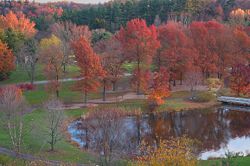
The main campus is marked by an irregular layout and eclectic architectural styles, including ornate Gothic, Victorian, Neoclassical buildings, and less decorative international and modernist structures. The more ornate buildings generally predate World War II. Because the student population doubled from 7,000 in 1950 to 15,000 by 1970, grandiosity was neglected in favor of less expensive and more rapidly constructed styles.[10] While some buildings are neatly arranged into quadrangles, others are packed densely and haphazardly. These eccentricities arose from the university's numerous, ever-changing master plans for the campus. For example, in one of the earliest plans, Frederick Law Olmsted, the designer of Central Park, outlined a "grand terrace" overlooking Cayuga Lake.[11] Because the terrace plan was dropped, McGraw Hall appears to face the wrong direction, facing the Slope rather than the Arts Quad.
The Ithaca Campus is among the rolling valleys of the Finger Lakes region and, atop the Hill, commands a panoramic view of the surrounding area. Two gorges bound Central Campus, which become popular swimming holes during the warmer months. Adjacent to the main campus, Cornell owns the 2,900-acre (11.7 km²) Cornell Plantations, a botanical garden containing flowers, trees, and ponds along manicured trails.
New York City campus
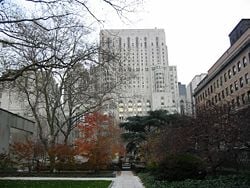
Weill Medical Center, often called Weill Cornell, is on the Upper East Side of Manhattan, New York City. It is home to two Cornell divisions, Weill Medical College and Weill Graduate School of Medical Sciences, and has been affiliated with the New York-Presbyterian Hospital since 1927.[12] Although their faculty and academic divisions are separate, the Medical Center shares its administrative functions with the Columbia University Medical Center. Weill Medical College is also affiliated with the neighboring Memorial Sloan-Kettering Cancer Center, Rockefeller University, and the Hospital for Special Surgery. Many faculty members have joint appointments at these institutions, and Weill Cornell, Rockefeller, and Memorial Sloan-Kettering offer the Tri-Institutional MD-PhD Program to selected entering Cornell medical students.
In addition to the medical center, New York City hosts local offices for some of Cornell's service programs. The College of Human Ecology and the College of Agriculture and Life Sciences provide means for students to reach out to local communities by gardening and building with the Cornell Cooperative Extension.[13] Students with the School of Industrial and Labor Relations' Extension & Outreach Program make workplace expertise available to organizations, union members, policy makers, and working adults.[14] The College of Engineering's Operations Research Manhattan, in the city's financial district, brings together business optimization research and decision support services aimed at strengthening industry and public sector collaboration.[15]
Qatar campus
Weill Medical College in Qatar is in Education City, near Doha. Opened in September 2004, it was the first American medical school outside the United States.[4] The college is part of Cornell's program to enhance its international influence. The College is a joint initiative of the Qatar government to strengthen its academic programs and provide better medical care in the country.[16] Along with its full four-year MD program, which mirrors the curriculum taught at Weill Medical College in New York City, the college offers a two-year undergraduate pre-medical program with a separate admissions process. This undergraduate program opened in September 2002 and was the first coeducational institute of higher education in Qatar.[17]
Library
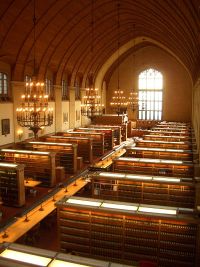
Cornell University Library has collections of printed volumes, digital resources, maps, media and archival materials, It holds over 8 million volumes and over a million ebooks. Approximately 90 percent of the 120,000 current serial titles are available online through the library, which serves almost 5 million journal article downloads per year.[18]
In 2018, The Princeton Review ranked it as the 7th best college library.[19]
The library plays an active role in furthering online archiving of scientific and historical documents. arXiv, an e-print archive created at Los Alamos National Laboratory by Paul Ginsparg, is operated and primarily funded by Cornell as part of the library's services. The archive has changed the way many physicists and mathematicians communicate, making the e-print a viable and popular means of announcing new research.
Press
The Cornell University Press, established in 1869 but inactive from 1884 to 1930, was the first university publishing enterprise in the United States.[20] It was established in the College of the Mechanic Arts (as mechanical engineering was called in the nineteenth century) because engineers knew more than literature professors did about running steam-powered printing presses. From its inception, the press has offered work-study financial aid: students with previous training in the printing trades were paid for typesetting and running the presses that printed textbooks, pamphlets, a weekly student journal, and official university publications.
The Press produces approximately 150 nonfiction titles each year, with particular strengths in anthropology, Asian studies, classics, geography, higher education, history (U.S., European, Asian, and military), literary and cultural studies, medieval studies, New York City and State, politics and international relations, Slavic studies, sociology, and urban studies.[20] Ebook editions of almost all Cornell titles published since 2011 are also available.
The press's acquisitions, editorial, production, and marketing departments have been located in Sage House since 1993.[20]
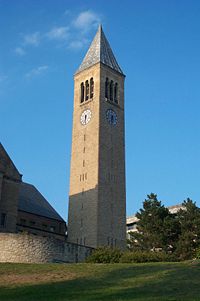
Other facilities
Cornell University owns and operates many facilities around the world. The Shoals Marine Laboratory, operated in conjunction with the University of New Hampshire,[21] is a seasonal marine field station dedicated to undergraduate education and research on 95-acre (0.4 km²) Appledore Island off the Maine–New Hampshire coast.
Many Cornell facilities focus on conservationism and ecology. The New York State Agricultural Experiment Station, operated by the College of Agriculture and Life Sciences, is in Geneva, New York, 50 miles (80 km) northwest of the main campus. The facility comprises 20 major buildings on 130 acres (0.5 km²) of land, as well as more than 700 acres (2.8 km²) of test plots and other lands devoted to horticultural research.[22] It also operates three substations, Vineyard Research Laboratory in Fredonia, Hudson Valley Laboratory in Highland and the Long Island Horticultural Research Laboratory in Riverhead.
The Cornell Laboratory of Ornithology in Sapsucker Woods in Ithaca, New York performs research on biological diversity, primarily in birds. In 2005, the lab announced that it had rediscovered the Ivory-billed woodpecker, long thought to be extinct.[23] The Animal Science Teaching and Research Center in Harford, New York and the Duck Research Laboratory in Eastport, New York are resources for information on animal disease control and husbandry.[24][25] The Arnot Teaching and Research Forest, a 4,075-acre (16.5 km²) forest 20 miles (32.2 km) south of the Ithaca campus, is the primary field location for faculty and student training and research related to professional forestry.[26] The mission of the Cornell Biological Field Station in Bridgeport, New York is "To conduct research in fisheries and aquatic ecology in New York State with a focus on Oneida Lake, the Great Lakes and other NYS inland lakes. To support the educational, outreach and extension programs of the Department of Natural Resources (DNR), the College of Agriculture and Life Sciences (CALS) and Cornell University."[27] In addition, the university operates biodiversity laboratories in Punta Cana, Dominican Republic and in the Amazon rainforest in Peru.[28][29]
The university also maintains offices for study abroad and scholarship programs. Cornell in Washington is a program that allows students to study for a semester in Washington, D.C. in research and internship positions while earning credit toward a degree.[30] Cornell in Rome, operated by the College of Architecture, Art, and Planning, allows students to use the city as a resource for learning architecture, urban studies, and art.[31] The College of Human Ecology offers the Urban Semester Program, an opportunity to take courses and complete an internship in New York City for a semester. As well, the Capital Semester program allows students to intern in the New York state legislature.[32]
Programs
Cornell offers undergraduate curricula with international focuses, including the Africana Studies, French Studies, German Studies, Jewish Studies, Latino Studies, Near Eastern Studies, Romance Studies, and Russian Literature majors. Cornell was the first university to teach modern Far Eastern languages.[33] In addition to traditional academic programs, Cornell students may study abroad on any of six continents.[34]
The Asian Studies major, South Asia Program, Southeast Asia Program, and the newly launched China and Asia-Pacific Studies (CAPS) major provide opportunities for students and researchers in Asia. Cornell has an agreement with Peking University allowing students in the CAPS major to spend a semester in Beijing.[35] Similarly, the College of Engineering has an agreement to exchange faculty and graduate students with Tsinghua University in Beijing, and the School of Hotel Administration has a joint master's program with Nanyang Technological University in Singapore. The College of Agriculture and Life Sciences has signed an agreement with Japan's National Institute of Agrobiological Sciences, [36] to engage in joint research and exchange graduate students and faculty members. It also cooperates in agricultural research with the Indian Council of Agricultural Research.[37]
In the Middle East, Cornell's efforts focus on biology and medicine. The Weill Cornell Medical College in Qatar trains new doctors to improve health services in the region. The university is also developing the Bridging the Rift Center, a "Library of Life" (or database of all living systems) on the border of Israel and Jordan, in collaboration with those two countries and Stanford University.[38]
In 2005, Cornell partnered with Queen's University in Canada to offer a joint Executive MBA. The only program of its kind in the world, graduates of the program earn both a Cornell MBA and a Queen's MBA. In 2015, the program was renamed Executive MBA Americas, and has expanded into Latin America.[39] This program is made possible through videoconferencing, and so students in Canada and the United States and Latin America share an interactive virtual classroom. There are also three intensives on the Queen's and Cornell campuses.[40]
Organization
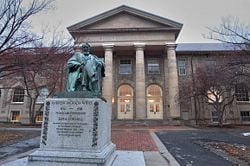
Cornell is a private institution, receiving most of its funding through tuition, research grants, and alumni contributions. Three of its undergraduate colleges and the graduate-level College of Veterinary Medicine are called contract colleges. These divisions receive partial funding from the state of New York to support their research and service mission in niche fields. Residents of New York enrolled in the contract colleges pay reduced tuition. Furthermore, the governor of the state serves as an ex-officio member of the board of trustees. Despite some similarities, Cornell's contract colleges are not public or state schools – they are private institutions that Cornell operates by contract with the state government.
Cornell is decentralized, with its colleges and schools exercising wide autonomy. Each defines its own academic programs, operates its own admissions and advising programs, and confers its own degrees. The only university-wide requirements for a baccalaureate degree are to pass a swimming test, take two physical education courses, and satisfy a writing requirement. Although students are affiliated with their individual college or school, they may take courses in any of the colleges, provided they have fulfilled the course prerequisites. A handful of inter-school academic departments offer courses in more than one college.
Seven schools provide undergraduate programs and an additional seven provide graduate and professional programs. Students pursuing graduate degrees in departments of these schools are enrolled in the Graduate School. The School of Continuing Education and Summer Sessions offers programs for college and high school students, professionals, and other adults.[41]
Undergraduate
Contract
|
Graduate and professional
Contract
|
Student Life
Activities
Cornell student organizations include over 1,000 different activities which run the gamut from kayaking to full-armor jousting, from varsity and club sports and a cappella groups to improvisational theater, from political clubs and publications to chess and video game clubs.[42] Student organizations also include a myriad of musical groups that play everything from classical, jazz, to ethnic styles in addition to the Big Red Marching Band, which performs regularly at football games and other campus events.[43]
Organized in 1868, the oldest student organization is the Cornell University Glee Club. The Cornell Daily Sun is the oldest continuously independent college daily newspaper in the United States, having published since September 1880.[44] Other campus publications include The Cornell Lunatic (campus humor magazine), The Cornell Review, Turn Left, The Cornell American, The Cornell Centrist, and The Cornell Moderator. WVBR is an independent radio station owned and operated by Cornell students, but not affiliated with or controlled by the university. During the week, it plays mostly rock music, and switches to specialty shows and community programming on the weekend. It also provides coverage of both Cornell and national sports.
Housing
University housing includes residence halls for undergraduates. Freshmen residences are grouped together on North Campus, while residences for transfer and upperlevel students are primarily located in Collegetown.[45]
Both single and family housing is available on North Campus for graduate and professional students.
Off campus housing includes fraternities and sororities, as well as rental opportunities.
Athletics
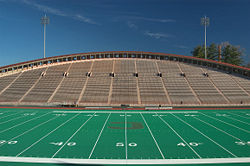
Cornell has 36 varsity sports teams that are known as the Big Red. An NCAA Division I-AA institution, Cornell is a member of the Ivy League and ECAC Hockey League and competes in the Eastern College Athletic Conference (ECAC), the largest athletic conference in North America.[46] (Note that the ECAC Hockey League is no longer affiliated with the ECAC.) The men's ice hockey team is the most historically successful of the varsity teams and is the university's most intently followed sport.
Cornell and the University of Pennsylvania are long-time rivals in football. With more than 1204 games played since their first meeting in 1893, this is the sixth most-played rivalry in college football.[47] In polo, the men's and women's teams maintain rivalries with the University of Virginia and the University of Connecticut.
In addition to the school's varsity athletics, club sports teams have been organized as student organizations under the auspices of the Dean of Students. Cornell's intramural program includes 30 sports. Beside such familiar sports such as flag football, squash, or horseshoes, such unusual offerings as "inner tube water polo" and formerly "broomstick polo" have been offered.[48] Cornell students also often participate in the International Rutabaga Curling Championship, held annually at the Ithaca Farmers' Market.[49]
Traditions
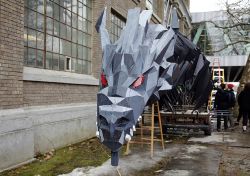
"Cornelliana" is a term for Cornell's traditions, legends, and lore. Cornellian traditions include Slope Day, a celebration held on the last day of classes, and Dragon Day, which includes the burning of a dragon built by architecture students. Dragon Day is one of the school's oldest traditions and has been celebrated annually since 1901.[50]
The university is also host to various student pranks. For example, on at least three different occasions the university has awoken to find something odd atop the 173-foot (52.7 m) tall McGraw clock tower — once a 60-pound (27 kg) pumpkin, once a banner reading "Who is John Galt?," and another time a disco ball.[51]
The school colors are carnelian (a shade of red) and white, a play on "Cornellian" and Andrew Dickson White. A bear is commonly used as the unofficial mascot, which dates back to the introduction of the mascot "Touchdown" in 1915, a live bear who was brought onto the field during football games.[52] The university's alma mater is Far Above Cayuga's Waters and its fight song is Give My Regards to Davy. People associated with the university are called "Cornellians." "Cornellian" is also used as an adjective and as the name of the university's yearbook.
Notable Alumni
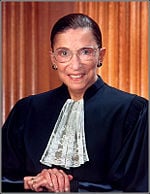
Cornellians are noted for their accomplishments in public, professional, and corporate life.[33][53] Former Taiwan President Lee Teng-hui, former President of Cuba Mario García Menocal, and former Iranian Prime Minister Jamshid Amuzegar all graduated from Cornell. In the United States, numerous Congressmen and Cabinet members, including Paul Wolfowitz and Janet Reno, and one Supreme Court justice, Ruth Bader Ginsburg, have been Cornellians. After his Cornell education, David Starr Jordan went on to become the founding president of Stanford University and a president of Indiana University. M. Carey Thomas founded Bryn Mawr College and was its second president.
In medicine, Dr. Robert Atkins developed the Atkins Diet, Dr. Henry Heimlich developed the Heimlich maneuver, and Wilson Greatbatch invented the first successful pacemaker. Dr. James Maas, both an alumnus and faculty member, coined the term "power nap." Cornellians also include medical personalities Dr. Benjamin Spock and Joyce Brothers, as well as the Nobel laureate maize geneticist Barbara McClintock.
A number of Cornellians have been prominent innovators, starting with Thomas Midgley, Jr., the inventor of Freon. Jeff Hawkins invented the Palm Pilot and subsequently founded Palm, Inc. Graduate Jon Rubinstein is credited with the development of the iPod. William Higinbotham developed Tennis for Two in 1958, one of the earliest computer games and the predecessor to Pong, and Robert Tappan Morris developed the first computer worm on the Internet. The most direct evidence of dark matter was provided by Vera Rubin. Jill Tarter became the director of SETI and Steve Squyres the principal investigator on the Mars Exploration Rover Mission. Eight Cornellians have served as NASA astronauts. Bill Nye is best known as "The Science Guy."
Nobel Prize in Literature winner Toni Morrison wrote Song of Solomon and won a Pulitzer Prize for her novel, Beloved. The Nobel Prize in Literature was also awarded to Pearl S. Buck, author of The Good Earth. E. B. White, author of Charlotte's Web and Stuart Little, co-wrote the influential writing guide The Elements of Style with fellow Cornellian William Strunk Jr. Other Cornellian writers include Laura Z. Hobson, Thomas Pynchon, and Kurt Vonnegut. Cornellian journalists include Margaret Bourke-White, Ann Coulter, Allison Danzig, Dick Schaap, Keith Olbermann, Kate Snow, and radio personality/former congressional candidate, Dave Ross.
Christopher Reeve is best known for his role as Superman, while comedian Frank Morgan is best known to younger generations as The Wizard of Oz. Jimmy Smits, best known for his roles on L.A. Law, The West Wing, and in the Star Wars films Episode II: Attack of the Clones and Episode III: Revenge of the Sith earned his MFA from Cornell. Cornellians have won Academy Awards and been enshrined on the Hollywood Walk of Fame. Mack David wrote Bibbidi-Bobbidi-Boo from the 1950 film Cinderella. Robert Alexander Anderson wrote the Christmas song Mele Kalikimaka. Peter Yarrow of Peter, Paul and Mary, singer-songwriter Harry Chapin, and modern composer Steve Reich attended Cornell.
The Empire State Building and Grauman's Chinese Theatre were designed by Cornell architects Richard Shreve and Raymond M. Kennedy, respectively. Edmund Bacon is best known for reshaping Philadelphia in the mid twentieth century.
In athletics, Cornellians have won Olympic gold medals, been inducted into sports halls of fame, and led numerous teams as general managers and coaches including Bruce Arena, former head coach of the United States men's national soccer team.
Notes
- ↑ 1.0 1.1 Cornell University's 'Any person ... any study' named nation's best college motto by magazine Cornell Chronicle, August 6, 2007. Retrieved May 22, 2018
- ↑ 2.0 2.1 Carl L. Becker. Cornell University: Founders and the Founding (Ithaca, NY: Cornell University Press, 1943, ISBN 0801490588).
- ↑ Kelsey O'Connor, What you need to know about Cornell: 150 facts Ithaca Journal, 2015. Retrieved May 22, 2018.
- ↑ 4.0 4.1 About Us: Purpose and Mission Weill Cornell Medical College in Qatar. Retrieved May 22, 2018.
- ↑ Cornell president joins Indian prime minister to open new chapter in science education. Cornell Chronicle, July 21, 2005. Retrieved May 23, 2018.
- ↑ Cornell University and Nanyang Technological University (Singapore) establish joint Master's program in Hospitality Management Cornell HospitalityNet, November 2, 2004. Retrieved May 23, 2018.
- ↑ Blaine Friedlander, Rawlings heads to China to sign partnership agreement and deliver keynote address at economic summit in Beijing. Cornell Chronicle, November 7, 2005. Retrieved May 23, 2018.
- ↑ 8.0 8.1 Cornell University - The Ithaca Campus. Cornell University. Retrieved May 23, 2018.
- ↑ Maps. Cornell University. Retrieved May 23, 2018.
- ↑ Daniel Margulis and John Schroeder, A Century at Cornell (Ithaca, NY: Cornell Daily Sun, 1980, ISBN 0938304003), 110-111.
- ↑ Kermit C. Parsons, The Cornell Campus: A History of its Planning and Development (Ithaca, NY: Cornell University Press, 1969), Ch. 3 "A Quadrangle of Stone."
- ↑ Weill Medical College of Cornell University - About Us. Cornell University. Retrieved May 23, 2018.
- ↑ Cornell Cooperative Extension. Cornell University. Retrieved May 23, 2018.
- ↑ About ILR. Cornell University Retrieved May 23, 2018.
- ↑ Operations Research Manhattan. Cornell University Retrieved May 23, 2018.
- ↑ Purpose and Mission. Weill Cornell Medicine - Qatar. Retrieved May 23, 2018.
- ↑ Overview Weill Cornell Medicine - Qatar. Retrieved May 23, 2018.
- ↑ Collections. Cornell University Library. Retrieved May 23, 2018.
- ↑ The Best 361 Colleges Rankings. The Princeton Review Retrieved May 4, 2018.
- ↑ 20.0 20.1 20.2 Mission Statement Cornell University Press Retrieved May 23, 2018.
- ↑ A short history of the Shoals Marine Laboratory Shoals Marine Laboratory. Retrieved May 23, 2018.
- ↑ New York State Agricultural Experiment Station. Cornell University. Retrieved May 23, 2018.
- ↑ Ivory-billed Woodpecker. Cornell University. Retrieved May 23, 2018.
- ↑ Harford Animal Science Teaching and Research Center. Cornell University. Retrieved May 23, 2018.
- ↑ Duck Research Laboratory. International Duck Research Cooperative, Inc. Retrieved May 23, 2018.
- ↑ Arnot Teaching and Research Forest. Cornell University. Retrieved May 23, 2018.
- ↑ CBFS Mission. Cornell Biological Field Station at Shackelton Point. Retrieved May 23, 2018.
- ↑ Biodiversity Laboratory at Punta Cana. Cornell University. Retrieved May 23, 2018.
- ↑ Cornell Undergraduate Research Program on Biodiversity. Cornell University. Retrieved May 23, 2018.
- ↑ Cornell in Washington. Cornell University Retrieved May 23, 2018.
- ↑ Cornell in Rome. Cornell University Retrieved May 23, 2018.
- ↑ Human Ecology Urban Semester Program in New York City. Cornell University. Retrieved May 23, 2018.
- ↑ 33.0 33.1 University Facts Cornell University. Retrieved May 23, 2018.
- ↑ About Us. Global Learning - Cornell University Retrieved May 26, 2018.
- ↑ Blaine Friedlander, Cornell China major sealed in Beijing as Rawlings signs agreement with Peking University. Cornell Chronicle, November 15, 2005. Retrieved May 26, 2018
- ↑ Krishna Ramanujan, Cornell signs research agreement with Japan's genome research institute . Cornell Chronicle, October 19, 2005. Retrieved May 26, 2018.
- ↑ Susan S. Lang, Cornell and India sign new agreement for agricultural development. Cornell Chronicle, December 13, 2005. Retrieved May 26, 2018.
- ↑ David Brand, Cornell and Stanford to work with Israel and Jordan on Bridging the Rift research center to include world's first databank for all living systems. Cornell Chronicle, February 26, 2004. Retrieved May 26, 2018.
- ↑ Canada’s Ivy League Meets The Original Ivy League The Executive MBA Americas. Retrieved May 26, 2018.
- ↑ How the Program Works The Executive MBA Americas. Retrieved May 26, 2018.
- ↑ School of Continuing Education and Summer Sessions. Cornell University. Retrieved May 26, 2018.
- ↑ Student Organizations Cornell University. Retrieved May 26, 2018.
- ↑ The Big Red Band has a long history. Cornell University Retrieved May 26, 2018.
- ↑ About. The Cornell Daily Sun. Retrieved May 26, 2018.
- ↑ Residence Halls Cornell University Retrieved May 26, 2018.
- ↑ ECAC History. ECAC Retrieved May 26, 2018.
- ↑ Mike Lopresti, 7 of the most-played college football rivalries of all time. NCAA, September 19, 2017. Retrieved May 26, 2018.
- ↑ Broomstick Polo. The Cornell Daily Sun, October 22, 1958. Retrieved May 26, 2018.
- ↑ The International Rutabaga Curl. Retrieved May 26, 2018.
- ↑ Dragon Day. Cornell University College of Architecture, Art, and Planning. Retrieved May 26, 2018.
- ↑ Cornell's giant pumpkin makes national news . Cornell Chronicle, November 3, 1997. Retrieved May 26, 2018.
- ↑ History of Athletics at Cornell University. Cornell University Athletics. Retrieved May 26, 2018.
- ↑ Glenn C. Altschuler, Isaac Kramnick, and R. Laurence Moore, The 100 Most Notable Cornellians (Ithaca, NY: Cornell University Press, 2003, ISBN 0801439582)
References
ISBN links support NWE through referral fees
- Altschuler, Glenn C., R. Laurence Moore, and Isaac Kramnick. The 100 Most Notable Cornellians. Ithaca, NY: Cornell University Press, 2003. ISBN 978-0801439582
- Becker, Carl L. Cornell University: Founders and the Founding. Ithaca, NY: Cornell University Press, 1943. ISBN 0801490588
- Hewett, Waterman Thomas. Cornell University, A History Vol. 3. reprint ed. Kessinger Publishing, 2007. ISBN 978-0548234891
- Margulis, Daniel and John Schroeder. A Century at Cornell. Ithaca, NY: Cornell Daily Sun, 1980. ISBN 0938304003
- Ostman, Ronald. Cornell Then & Now. McBooks Press, 2003. ISBN 978-1590130452
- Parsons, Kermit C. The Cornell Campus: A History of its Planning and Development. Ithaca, NY: Cornell University Press, 1969. ISBN 0801403294
External links
All links retrieved April 6, 2022.
- Cornell University - Official website
- Alumni.Cornell - The official website of the alumni, parents, and friends of Cornell University
- Undergraduate Admissions
- CUinfo - Campus information portal
- Cornell Big Red - Official athletics site
- Legal Information Institute - The Law School's public information service
- Cornell Cinema
- Cornell University at College Factual
| The Ivy League |
|---|
| Brown (Bears) • Columbia (Lions) • Cornell (Big Red) • Dartmouth (Big Green) • Harvard (Crimson) • Penn (Quakers) • Princeton (Tigers) • Yale (Bulldogs) |
Credits
New World Encyclopedia writers and editors rewrote and completed the Wikipedia article in accordance with New World Encyclopedia standards. This article abides by terms of the Creative Commons CC-by-sa 3.0 License (CC-by-sa), which may be used and disseminated with proper attribution. Credit is due under the terms of this license that can reference both the New World Encyclopedia contributors and the selfless volunteer contributors of the Wikimedia Foundation. To cite this article click here for a list of acceptable citing formats.The history of earlier contributions by wikipedians is accessible to researchers here:
- Cornell_University history
The history of this article since it was imported to New World Encyclopedia:
- History of "Cornell University"
Note: Some restrictions may apply to use of individual images which are separately licensed.
↧ Download as ZWI file | Last modified: 02/04/2023 02:31:12 | 33 views
☰ Source: https://www.newworldencyclopedia.org/entry/Cornell_University | License: CC BY-SA 3.0
 ZWI signed:
ZWI signed: KSF
KSF